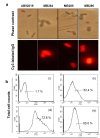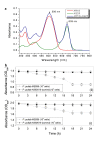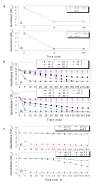Decolorization of industrial synthetic dyes using engineered Pseudomonas putida cells with surface-immobilized bacterial laccase
- PMID: 22686507
- PMCID: PMC3439328
- DOI: 10.1186/1475-2859-11-75
Decolorization of industrial synthetic dyes using engineered Pseudomonas putida cells with surface-immobilized bacterial laccase
Abstract
Background: Microbial laccases are highly useful in textile effluent dye biodegradation. However, the bioavailability of cellularly expressed or purified laccases in continuous operations is usually limited by mass transfer impediment or enzyme regeneration difficulty. Therefore, this study develops a regenerable bacterial surface-displaying system for industrial synthetic dye decolorization, and evaluates its effects on independent and continuous operations.
Results: A bacterial laccase (WlacD) was engineered onto the cell surface of the solvent-tolerant bacterium Pseudomonas putida to construct a whole-cell biocatalyst. Ice nucleation protein (InaQ) anchor was employed, and the ability of 1 to 3 tandemly aligned N-terminal repeats to direct WlacD display were compared. Immobilized WlacD was determined to be surface-displayed in functional form using Western blot analysis, immunofluorescence microscopy, flow cytometry, and whole-cell enzymatic activity assay. Engineered P. putida cells were then applied to decolorize the anthraquinone dye Acid Green (AG) 25 and diazo-dye Acid Red (AR) 18. The results showed that decolorization of both dyes is Cu(2+)- and mediator-independent, with an optimum temperature of 35°C and pH of 3.0, and can be stably performed across a temperature range of 15°C to 45°C. A high activity toward AG25 (1 g/l) with relative decolorization values of 91.2% (3 h) and 97.1% (18 h), as well as high activity to AR18 (1 g/l) by 80.5% (3 h) and 89.0% (18 h), was recorded. The engineered system exhibited a comparably high activity compared with those of separate dyes in a continuous three-round shake-flask decolorization of AG25/AR18 mixed dye (each 1 g/l). No significant decline in decolorization efficacy was noted during first two-rounds but reaction equilibriums were elongated, and the residual laccase activity eventually decreased to low levels. However, the decolorizing capacity of the system was easily retrieved via a subsequent 4-h cell culturing.
Conclusions: This study demonstrates, for the first time, the methodology by which the engineered P. putida with surface-immobilized laccase was successfully used as regenerable biocatalyst for biodegrading synthetic dyes, thereby opening new perspectives in the use of biocatalysis in industrial dye biotreatment.
Figures









Similar articles
-
Decolorization of textile dye RB19 using volcanic rock matrix immobilized Bacillus thuringiensis cells with surface displayed laccase.World J Microbiol Biotechnol. 2017 Jun;33(6):123. doi: 10.1007/s11274-017-2290-x. Epub 2017 May 22. World J Microbiol Biotechnol. 2017. PMID: 28534112
-
Efficient degradation and detoxification of structurally different dyes and mixed dyes by LAC-4 laccase purified from white-rot fungi Ganoderma lucidum.Ecotoxicol Environ Saf. 2024 Jul 1;279:116450. doi: 10.1016/j.ecoenv.2024.116450. Epub 2024 May 19. Ecotoxicol Environ Saf. 2024. PMID: 38768540
-
Decolorization of Acid Green 25 by Surface Display of CotA laccase on Bacillus subtilis spores.J Microbiol Biotechnol. 2019 Sep 28;29(9):1383-1390. doi: 10.4014/jmb.1907.07019. J Microbiol Biotechnol. 2019. PMID: 31434174
-
Immobilized laccase: an effective biocatalyst for industrial dye degradation from wastewater.Environ Sci Pollut Res Int. 2023 Aug;30(36):84898-84917. doi: 10.1007/s11356-023-28275-5. Epub 2023 Jun 28. Environ Sci Pollut Res Int. 2023. PMID: 37369903 Review.
-
Current Development in Decolorization of Synthetic Dyes by Immobilized Laccases.Front Microbiol. 2020 Sep 30;11:572309. doi: 10.3389/fmicb.2020.572309. eCollection 2020. Front Microbiol. 2020. PMID: 33101245 Free PMC article. Review.
Cited by
-
Decolorization of Textile Dye by Spore Surface Displayed Small Laccase for the Enhanced Thermal Stability and Robust Repeated Reaction.Biotechnol Bioprocess Eng. 2022;27(6):930-937. doi: 10.1007/s12257-022-0317-0. Epub 2022 Dec 29. Biotechnol Bioprocess Eng. 2022. PMID: 36593775 Free PMC article.
-
Applications and immobilization strategies of the copper-centred laccase enzyme; a review.Heliyon. 2023 Jan 25;9(2):e13156. doi: 10.1016/j.heliyon.2023.e13156. eCollection 2023 Feb. Heliyon. 2023. PMID: 36747551 Free PMC article. Review.
-
Microbial degradation of contaminants of emerging concern: metabolic, genetic and omics insights for enhanced bioremediation.Front Bioeng Biotechnol. 2024 Sep 19;12:1470522. doi: 10.3389/fbioe.2024.1470522. eCollection 2024. Front Bioeng Biotechnol. 2024. PMID: 39364263 Free PMC article. Review.
-
Development of a whole-cell biocatalyst for diisobutyl phthalate degradation by functional display of a carboxylesterase on the surface of Escherichia coli.Microb Cell Fact. 2020 May 29;19(1):114. doi: 10.1186/s12934-020-01373-6. Microb Cell Fact. 2020. PMID: 32471417 Free PMC article.
-
The ant Lasius niger is a new source of bacterial enzymes with biotechnological potential for bleaching dye.Sci Rep. 2019 Oct 23;9(1):15217. doi: 10.1038/s41598-019-51669-w. Sci Rep. 2019. PMID: 31645628 Free PMC article.
References
-
- Martins LO, Soares CM, Pereira MM, Teixeira M, Costa T, Jones GH, Henriques AO. Molecular and biochemical characterization of a highly stable bacterial laccase that occurs as a structural component of the Bacillus subtilis endospore coat. J Biol Chem. 2002;277:18849–18859. doi: 10.1074/jbc.M200827200. - DOI - PubMed
Publication types
MeSH terms
Substances
LinkOut - more resources
Full Text Sources
Other Literature Sources
Research Materials

